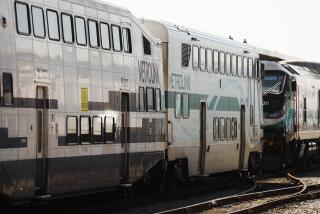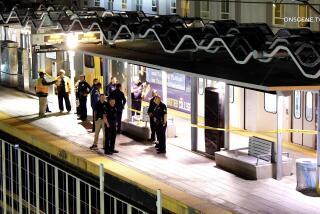Man Dies as He Runs in Front of a Train : Accident: Richard Lee, 19, was returning with friends from Torrey Pines State Beach when he apparently tried to race the 45 m.p.h. freight. He is the eighth to die on North County tracks since 1990.
A 19-year-old man was struck and killed in Del Mar early Wednesday when he apparently ran in front of a southbound freight train traveling at 45 m.p.h., the San Diego County Sheriff’s Department reported.
Richard Lee of Mira Mesa was killed instantly when he tried to cross the tracks in front of a Santa Fe train about 12:10 a.m., Sheriff’s Sgt. Sean Gerrity said.
Lee is the eighth person to die since 1990 on North County tracks.
Lee was returning with his wife, Anna, and about five friends from an outing at Torrey Pines State Beach when the group decided to walk along the tracks. The area is closed to public access near North Torrey Pines Road, Gerrity said. He said he did not know where the group was headed.
What happened next is unclear, but a spokesman for Santa Fe Railway said Lee suddenly began to race alongside the four-locomotive, 52-car freight headed downhill toward San Diego and attempted to step in front of the train.
“It was like he was racing the train on foot and then jumped in front of the train, trying to beat it,” Santa Fe spokesman Michael Martin said. “The crew said they saw him a couple of seconds, maybe, before they hit him, but he suddenly jumped in front of the train, and those trains can’t stop on a dime.”
A freight train may take a mile to stop after braking, Martin said.
The San Diego coroner’s office said blood tests to determine Lee’s blood alcohol level will be released within several weeks.
Martin said Lee’s friends “appeared intoxicated” to the three-man crew. After the accident, he said, Lee’s friends “verbally attacked” the motorman, brakeman and conductor. The crew radioed a dispatcher, who called police, he said.
The train was headed to San Diego from Barstow on the 100-year-old line, carrying building materials and boxcars full of food, Martin said.
On the stretch of track where Lee was killed, there are several “No Trespassing” and “Danger” signs posted, but people usually ignore the signs to take a shortcut, Martin said.
The nearest public access across the tracks is about half a mile away at McGonigle Road, Martin said.
Freight trains on this stretch of track have a speed limit of 50 m.p.h., while Amtrak passenger trains traveling on the same line may go up to 90 m.p.h., Martin said. Speed limits on trains are set by the Federal Railroad Administration, Martin said.
Lee’s death represents the latest in a series of accidents to plague the train line in San Diego County.
In February, 1991, an 18-month-old toddler playing on the tracks in Encinitas was killed by an Amtrak train traveling at 88 m.p.h.
On Oct. 5, 1990, a Carlsbad grocery clerk was killed by an Amtrak train while he carried his bicycle near Basilone Road north of Oceanside. Eight days later, a passenger train struck and killed a woman as she sat smoking a cigarette on the tracks near Encinitas.
On Oct. 21, an Amtrak train struck and killed two migrant workers as they reportedly sat on the tracks playing cards in Leucadia.
Two others died on Dec. 5, 1990, when Usha Waney, 47, of La Jolla was killed instantly by a 2,000-ton train as she rushed to cross the tracks near the Del Mar Amtrak station, which was filled with commuters. Roberta Halpern, 44, of Encinitas died while she and her husband rushed to pull Waney away from the oncoming train.
Waney’s family is scheduled to be awarded an undisclosed settlement by Santa Fe, Amtrak and others today, officials said.
The 1990 spate of deaths brought public outcry and moved Santa Fe and Amtrak officials, various public transit groups and the Public Utilities Commission to participate in the national “Operation Lifesaver” program, designed to educate the public about train safety.
The program focused on the San Diego area until September, 1991, when the program was phased out because “you can’t sustain a peak effort but for so long,” Martin said.
“I am not aware of any plans to revive Operation Lifesaver in that area,” Martin said. “We have to look and see if there needs to be another campaign in that area,” he said.
There are also no plans to put up fencing along the fatal stretch where Lee was killed.
“We are opposed to fencing because it just doesn’t work, it isn’t practical. We put up fencing, and people tear it down,” Martin said. “Regardless of how intense the effort to talk about safety is, people sometimes wrestle with a train, and they lose.”
More to Read
Sign up for Essential California
The most important California stories and recommendations in your inbox every morning.
You may occasionally receive promotional content from the Los Angeles Times.










